The thought of bringing a Poodle home can be quite exciting for any new or experienced dog owner. Many people might be prepared to buy their food, organize their vaccinations, toys, bedding, and more, but what about their bath routine?
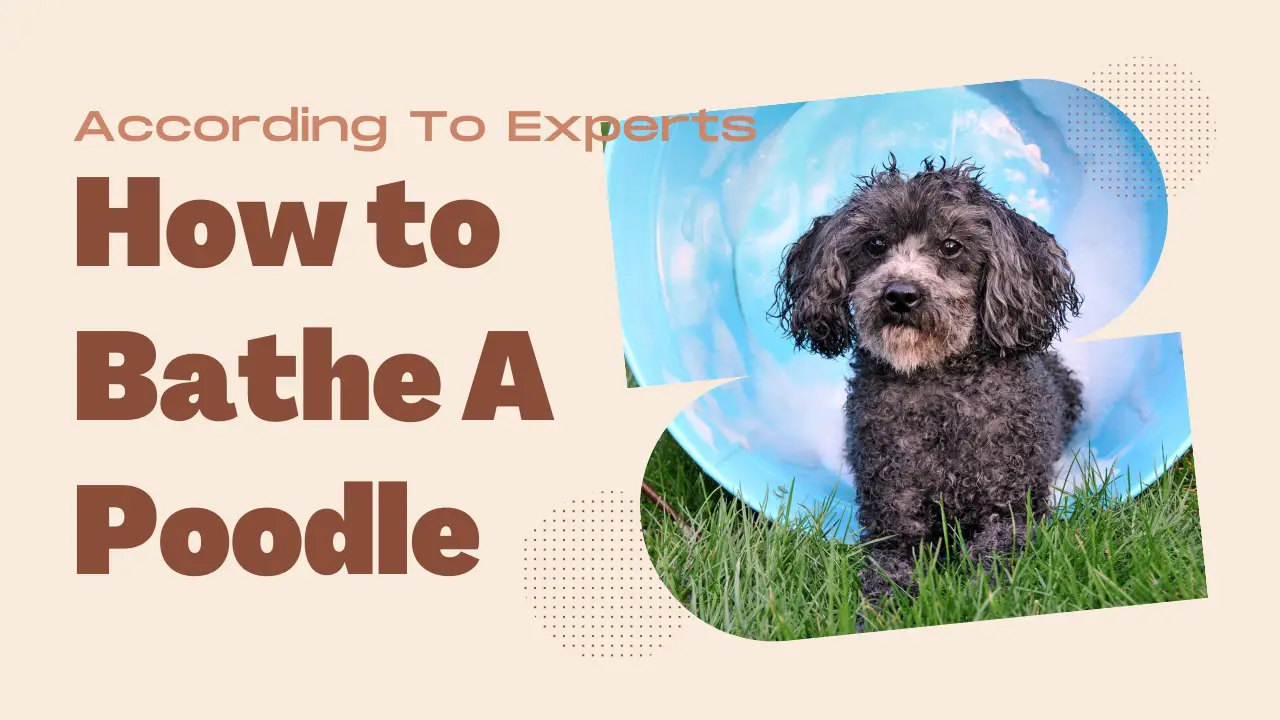
Sometimes, bathing a Poodle can often be overlooked due to its other necessary needs to live a healthy life. But, while it’s not as regular as some tasks that dog owners must conduct, bathing should be treated as seriously as the others.
Bathing a Poodle the right way can help reduce the risk of ear infections, tear stains, and keep their hair intact. But, the problem is on the information-rich internet; there can be multiple ways to bathe a Poodle, causing confusion. Therefore, to save you time and overwhelm, I will cover everything you need to know about Poodle bathing here today.

Read our Smart Poodles - Smart Tricks eBook for only $2.99
Dive into a treasure trove of engaging tricks and tips designed specifically for your poodle!
What Will You Learn? 👇
How often should Poodles bathe?
On average, you should bathe a Poodle every 3 weeks. This allows their skin and coat to reset back to normal. There is a process regardless of the amount of exercise or how much dirt or debris is collected in their coat.
As soon as a Poodle is bathed, its skin will release a small amount of natural oils. Together these oils start to help moisturize and serve as a barrier to their skin. But, over days, weeks and months, these oils can accumulate, making them unhealthy to the skin.
When these oils start to build up, some of them stay on their skin as their coat holds it. At the 3 week period, oils begin to clog the pores of their skin collecting small amounts of debris. The more debris trapped their coat, the more likely it will start to produce a foul-smelling odor. Trust me; no one wants a Poodle that smells bad!
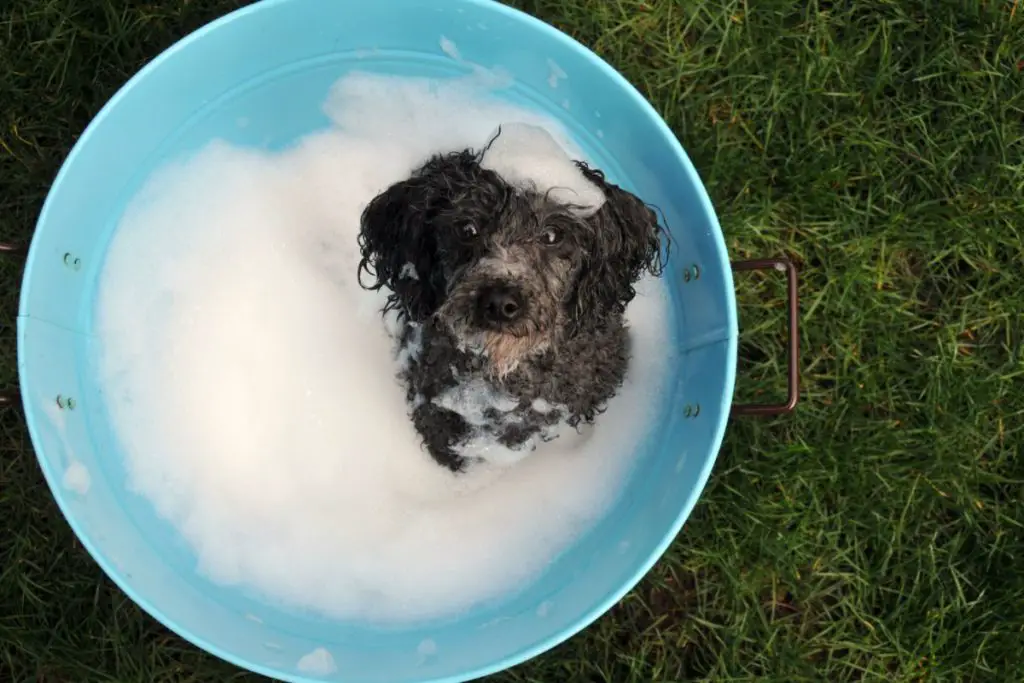
Plus, bathing a Poodle every 3 weeks will help do the following:
- Rinse off any remaining oils
- Clean debris and dirt
- Keep the skin moisturized without heavy residue
- Protect their coat from external damage from the sun, cold air, and contact from friction-filled surfaces
What Do You Need to Prepare?
Now that you have a basic idea of their bathing schedule, let’s prepare a Poodle for bathing.
Generally, when preparing a Poodle, you’ll want to split it into two categories: preparing their coat and the facilities.
Preparing their coat
Before you bathe your Poodle, you’ll want to make sure their coat is prepared. With a brush and comb, you should aim to remove any dead hairs or tangles in its coat. Even though the Poodle is a low shedding breed, it is known to have hairs released into its coat due to its hair-growing life cycle. Because of this, hairs can often fall on the floor or linger in their coat.
Brushing is also equally important, as it helps remove any dirt and debris beforehand. To ensure the dirt is removed successfully, you’ll want to ensure the brushing you do is thorough on the outside and is free from mats before it’s wet. This is because wet mats can be incredibly difficult to remove with a brush. Plus, once shampoo is applied to their mats, it can stay trapped inside, making it tricky to rinse.
Preparing the bathing facilities
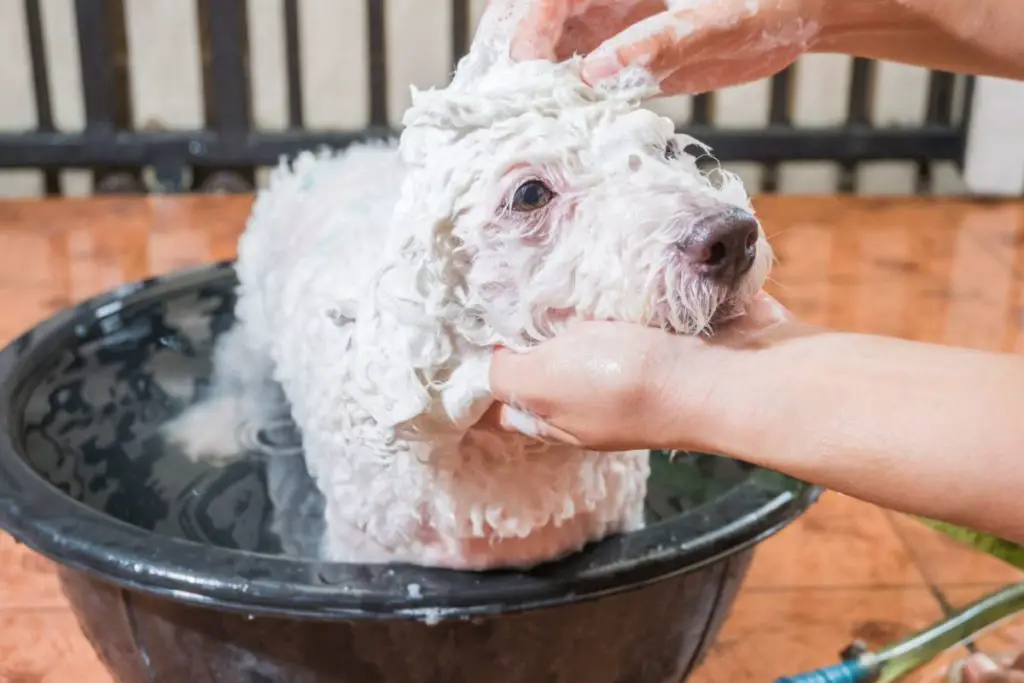
In addition to preparing your Poodle, you’ll want to save time bathing them by preparing their bath. After all, if unprepared, a bathing and drying routine for a Poodle can take a long time! Take this time to gather all of your bathing supplies and keep them nearby you.
If you plan on using a grooming table, you’ll want to remove any hairs and place a soft towel across the top. Moreover, if you own a young Poodle puppy or a toy Poodle, you’ll first want to clean the kitchen sink.
The bathing tools and products you’ll want to keep close by are:
- Cotton
- Rubber mat for the tub or sink
- Shampoo brush
- Sponge/washcloth
- Petroleum jelly a.k.a. Vaseline
- A water hose or plastic container
- Dog shampoo (one that enhances their color)
- Dog Conditioner or Creme rinse
- Clean, soft bath towels
After you’ve gathered your supplies, you will want to protect your Poodle’s ears to stop water from entering their canal. Always use an ample amount of cotton and gentle plug it in. If your Poodle suffers from many ear problems, you’ll want to add vaseline to ensure water does not get in.
If you have a Poodle that regularly enters shows, you’ll want to remove their topknot, bands, and any ear wrappers they may have. You might find it also beneficial to separate their long mane in the center of their back using a pin brush.
Bathing Steps
When it comes to bathing a Poodle, there are typically six steps to doing so, two of which have been mentioned above. In total, they are the following:
- Preparing the Poodle
- Preparing their bathing facilities
- Shampooing
- Rinsing
- Applying cream rinse or conditioner
- Drying
Since I’ve already covered stages 1 and 2, I will highlight 3-5 in a bit more detail.
Shampooing
While many Poodle owners are already are of this, in case your not, never use human shampoo on Poodles. When you’re bathing them, it must be dog-friendly shampoo, one that’s recommended ideally by your vet!
This is because dog shampoo contains balanced PH levels, making it suitable for their skin and coat, keeping them healthy. The shampoos can be alkali, acidic or neutral. Most of the time, their shampoos fall on 7 or higher on the PH scale, being neutral or alkaline.
Ideally, you should use an alkaline shampoo with a rating between 6.5-8; anything lower will be too acidic and dangerous for their skin. If you use acid-base shampoo, you could risk their coats becoming stained and uneven.
Moreover, if you have a lighter-colored Poodle or one with stains, you might want to use a dog shampoo that is color enhancing. These shampoos don’t have any dyes in them; instead, they elevate the natural color of your Poodles coat.
They also work well on white and light type Poodles, as they help remove any gray or yellow discolorations. Sometimes they can be beneficial for black or brown poodles, as they can help remove orange or red tipping, making it look more of a solid color.
So, how do you apply shampoo to a Poodle?
When looking to add shampoo to a Poodle, there are usually two ways you can do it. The first one is keeping the Poodle standing upright in the tub. When standing, apply warm water using a hose or a container pouring onto the coat. Once their coat is wet, massage shampoo into their roots but do not rub. The other way is to use a handheld spray, keeping the nozzle near their body when spraying.
Rinsing
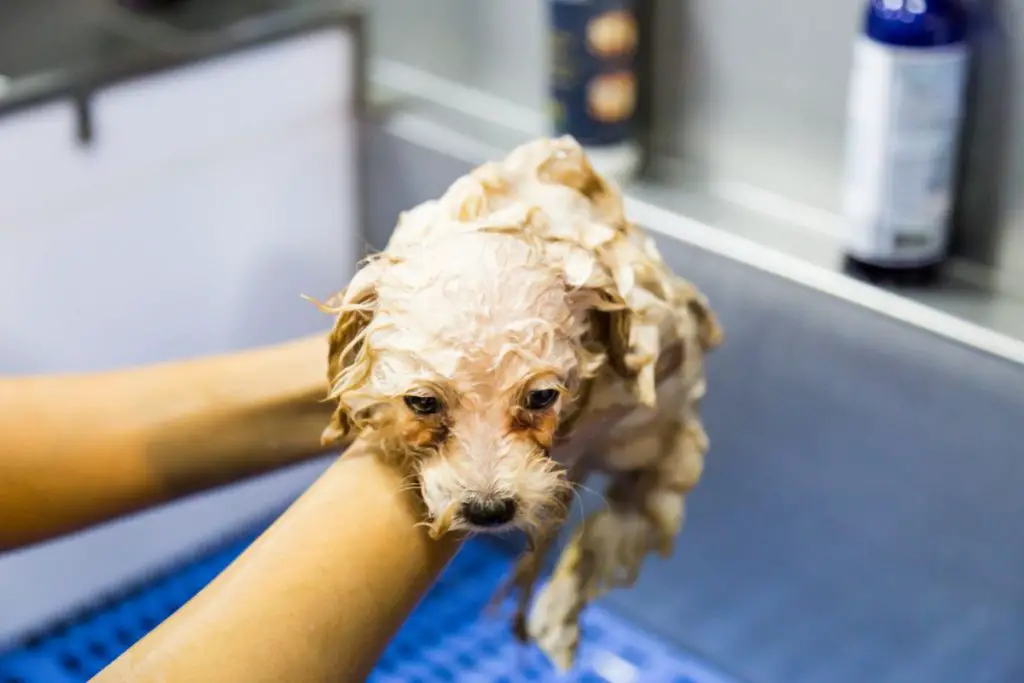
Next, you must rinse a Poodle thoroughly to remove any lingering shampoo from their curls. You’ll want to rinse starting from their head, covering their eyes and ear flaps with your hands.
Ideally, you should use warm water working down their neck, back, tail, sides, under the stomach, legs, and feet. Keep rinsing thoroughly to make sure the water that comes off is clear, and there are no soap suds remaining. Make sure you do this thoroughly because if there’s any shampoo left, it can make their coat look dull and easily make their skin irritated, causing them to scratch.
Applying Conditioner (optional)
You shouldn’t just use shampoo when bathing a Poodle, which can contribute to tangles. After you’ve rinsed your Poodle well, you’ll want to apply dog-friendly conditioner to keep their coat soft. Plus, this conditioner helps protect their hair by moisturizing, smoothing their cuticles, restructuring their hair shaft, restoring color depth and elasticity.
Before applying the conditioner, always make sure you squeeze any excess water out first with your fingertips. Then after this, gently apple conditioner into their coat to ensure it fits in well. Then leave it on for a few minutes and rinse well.
Drying
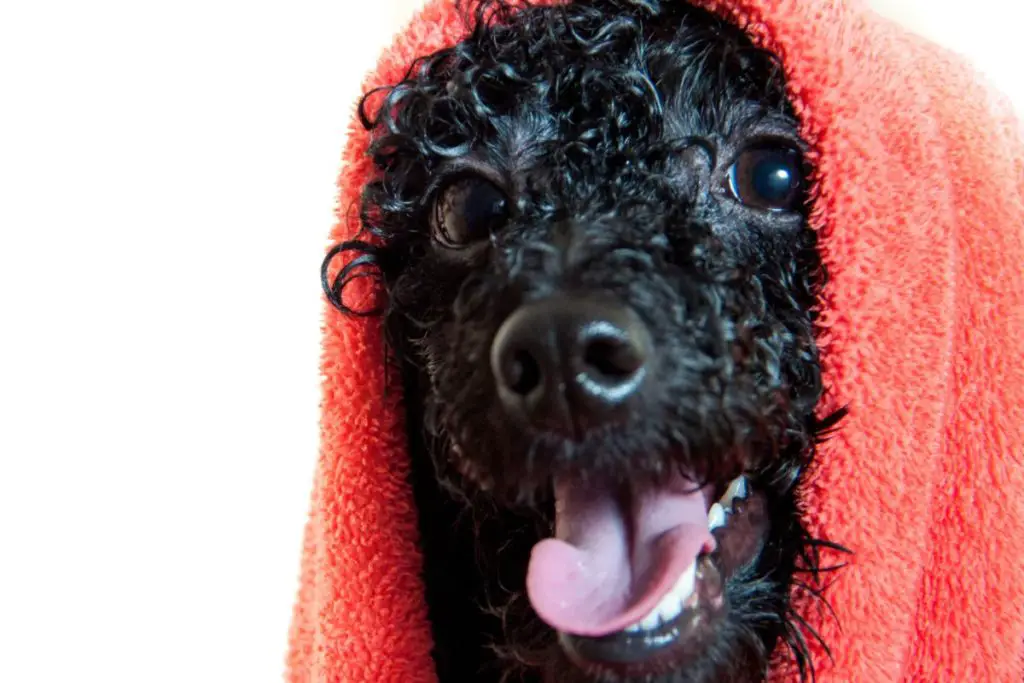
After rinsing your Poodle, you’ll want to gently lift them out of the tub or skin and place them in a soft absorbent towel. It’s more than likely that a Poodle will start shivering due to the sudden temperature change, so they must be well insulated.
You should gently wipe your Poodle with a towel to dry them. You mustn’t rub them as this can contribute to mats. If your Poodle has long fur, you might want to use two towels, opting for another dry one once the first becomes wet. You should also remove the cotton balls from their ears too.
Following this, you should gently blow-dry their fur while brushing. If possible, try and use a hairdryer designed specifically for Poodles, as they can reach and help fluff their undercoat. These hairdryers also reduce the risk of their skin being burnt and are typically hands-free.
Always ensure that you dry your Poodle well. Sometimes, it can become easy to feel like they’re dry, but most of the time, only their outer coat is, and their undercoat is still wet. If their undercoat is wet, it can become a breeding ground for bacteria, where yeast and bacteria can proliferate.
Conclusion
Overall, bathing a Poodle is something you should do every 3 weeks. Looking at the six bathing steps, it might seem like quite a tiring and lengthy procedure, but one that can be shortened if you prepare yourself. Always make sure you opt for using a dog-friendly shampoo and conditioner to keep their coat healthy and intact.
Most importantly, when bathing them, you should use the positive reinforcement approach. Simply giving a treat after a bath will help reinforce their good behavior and allow them to look forward to the experience in the long term.
💭 Do you have any tips for bathing a Poodle? Comment with your suggestions down below!
Marko is the founder and author at PoodleHQ, where he blends profound expertise with formal training in Animal Behavior and Canine Genetics. With multiple generations of poodles under his care, he’s a breed connoisseur, honored with the Canine Care Excellence Award and lauded by the International Pet Enthusiasts Association.


My mini guy is white or cream colored. Has seizures at the groomers while bathing. We have tried 3 different meds for seizures and anxiety, but still happens. No one wants to bathe him. I am willing to try it on my own, but honestly never saw him have a seizure and I’m afraid I’ll fold and won’t know what to do. Heart vs brain. Any suggestions for me? He is 12 yo. Thanks
Hi Pam
It may be best to consult with your veterinarian to determine the best course of action for your dog. Seizures can be caused by a variety of factors, and it’s important to get a proper diagnosis and treatment plan.
Medication may help to reduce the frequency and severity of seizures, but it’s also important to try to identify and address any triggers for the seizures, such as bathing.
Your vet may also be able to recommend a groomer who is experienced in handling dogs with seizures or anxiety. It’s important to remember to stay calm and keep your dog safe during a seizure, and to contact your vet immediately if a seizure lasts for more than a few minutes or if your dog has multiple seizures in a short period of time.